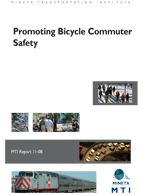- 408-924-7560
- mineta-institute@sjsu.edu
- Donate
Promoting Bicycle Commuter Safety
A basic premise in this report is that cycling should be encouraged because as the number of cyclists increases, the attention of motorists and safety improves; however, an important caveat is that the number of cyclists has to be commensurate with the infrastructure built for cycling to enhance their safety.
We present an overview of the risks associated with cycling to emphasize the need for safety. We focus on the application of frameworks from social psychology to education, one of the 5 Es—engineering, education, enforcement, encouragement, and evaluation. We use the structure of the 5 Es to organize information with particular attention to engineering and education in the literature review. Engineering is essential because the infrastructure is vital to protecting cyclists. Education is emphasized since the central focus of the report is safety.
A series of case studies gives first hand information about bicycle safety. The first three in northern California—covering education in relation to safety in San José; engineering and evaluation in Berkeley; engineering, education, and enforcement in Davis—and the Bicycle Transportation Alliance in the Portland, Oregon area, provide an effective example of the education and encouragement dimensions of the 5 Es. We note the need for future research or evaluation, with particular reference to the use of the social psychological model presented herein. Another critical area for future research is the role of enforcement. What are the most effective ways to get cyclists to follow the rules?
We see the value added of the present report to the extant literature as the following: a clear and concise discussion of safety education, case studies that exemplify the 5 Es and permit the reader to more actively engage in the stories told by the case authors, and the social psychological model to consider when designing the 5 Es. The Health Belief Model’s key elements could be applied to the 5 Es in the planning process.
ASBJORN OSLAND, PhD
Asbjorn Osland, Professor of Management, at San José State University, received his doctorate and MBA from Case Western Reserve University. He also holds an MSW and a post-baccalaureate in accounting. He has taught full time since 1993. Before that he worked abroad in Latin America and West Africa for 13 years for Chiquita Brands (2 years in Panama), Plan International (10 years in various countries), and Peace Corps in Colombia. His research interests are case writing, business and society, and international HRM, with over 60 published articles, cases and chapters and a comparable number of conference presentations.
-
Contact Us
San José State University One Washington Square, San Jose, CA 95192 Phone: 408-924-7560 Email: mineta-institute@sjsu.edu






